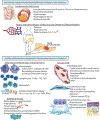Current Status and Principles for the Treatment and Prevention of Diabetic Foot Ulcers in the Cardiovascular Patient Population: A Scientific Statement From the American Heart Association
- PMID: 38095068
- PMCID: PMC11067094
- DOI: 10.1161/CIR.0000000000001192
Current Status and Principles for the Treatment and Prevention of Diabetic Foot Ulcers in the Cardiovascular Patient Population: A Scientific Statement From the American Heart Association
Abstract
Despite the known higher risk of cardiovascular disease in individuals with type 2 diabetes, the pathophysiology and optimal management of diabetic foot ulcers (DFUs), a leading complication associated with diabetes, is complex and continues to evolve. Complications of type 2 diabetes, such as DFUs, are a major cause of morbidity and mortality and the leading cause of major lower extremity amputation in the United States. There has recently been a strong focus on the prevention and early treatment of DFUs, leading to the development of multidisciplinary diabetic wound and amputation prevention clinics across the country. Mounting evidence has shown that, despite these efforts, amputations associated with DFUs continue to increase. Furthermore, due to increasing patient complexity of management secondary to comorbid conditions, such as cardiovascular disease, the management of peripheral artery disease associated with DFUs has become increasingly difficult, and care delivery is often episodic and fragmented. Although structured, process-specific approaches exist at individual institutions for the management of DFUs in the cardiovascular patient population, there is insufficient awareness of these principles in the general medicine communities. Furthermore, there is growing interest in better understanding the mechanistic underpinnings of DFUs to better define personalized medicine to improve outcomes. The goals of this scientific statement are to provide salient background information on the complex pathogenesis and current management of DFUs in cardiovascular patients, to guide therapeutic and preventive strategies and future research directions, and to inform public policy makers on health disparities and other barriers to improving and advancing care in this expanding patient population.
Keywords: AHA Scientific Statements; amputation, surgical; cardiovascular diseases; diabetes, type 2; diabetic foot; health care disparities; health inequities; peripheral arterial disease.
Conflict of interest statement
The American Heart Association makes every effort to avoid any actual or potential conflicts of interest that may arise as a result of an outside relationship or a personal, professional, or business interest of a member of the writing panel. Specifically, all members of the writing group are required to complete and submit a Disclosure Questionnaire showing all such relationships that might be perceived as real or potential conflicts of interest.
Disclosures
Writing Group Disclosures [Table: see text]
Reviewer Disclosures [Table: see text]
Figures





References
-
- van Netten JJ, Bus SA, Apelqvist J, Lipsky BA, Hinchliffe RJ, Game F, Rayman G, Lazzarini PA, Forsythe RO, Peters EJG, et al.; International Working Group on the Diabetic Foot. Definitions and criteria for diabetic foot disease. Diabetes Metab Res Rev. 2020;36(Suppl 1):e3268. doi: 10.1002/dmrr.3268 - DOI - PubMed

